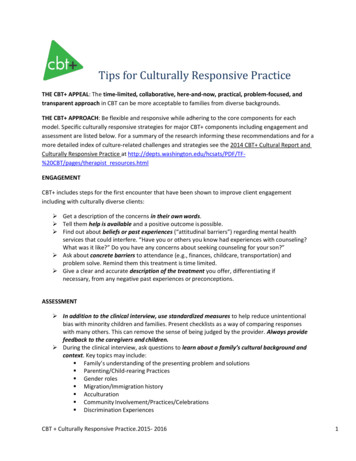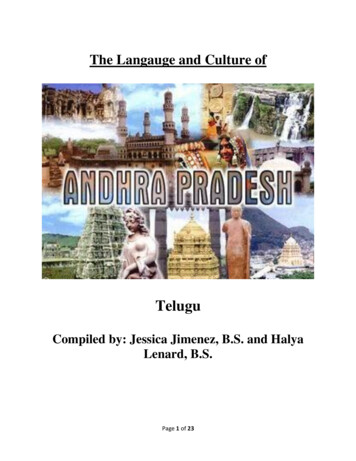
Transcription
The Langauge and Culture ofTeluguCompiled by: Jessica Jimenez, B.S. and HalyaLenard, B.S.Page 1 of 23
Table of ContentsGeographical Region/ Distribution .p.3Demographic Information p. 4History of Telugu .p. 5Social Aspects & Culture .p.6Linguistic Features .p. 10Words & Phrases p.16Linguistic Community . p.17Specialized Speech Language Pathologists p.18Test and Assessment Materials .p.19Additional Resources . p.20References p.22Page 2 of 23
Geographical RegionAndhra Pradesh, the main state Telugu is spoken in, is located in southeast India. To the north ofAndhra Pradesh are the states of Madhya Pradesh, Chattisgarh, and Orissa. To the east lies theBay of Bengal. To the south are the states of Tamil Nadu and Karnataka. To the west isMahrashtra. The capital of Andhra Pradesh is the city of Hyderabad. It covers an area of 275,045sq. km. It is divided into three zones of Coastal Plains, Eastern Ghats, and the plains. Theclimate is tropical.Above picture retrieved from: pradeshmicrofinance.jpgPage 3 of 23
DemographicsPopulation: 75,727,541 (2001 Census)5th Largest State in India-based on geographical area and size of populationDistricts: 23Town: 210Villages: 28,123Literacy Rate: 61.11%Highest in capitol city of Hyderabad: 79.04%Unemployment rate: 6.67%The main staples grown are rice, jowar, bajra, maize, red gram, Bengal gram, black gram, greengram, horse gram, chillies, onions, groundnut, castor, sesasmum, sunflower, cashewnut, cotton,tobacco, sugarcane, coconut, turmeric, bananas, and mangoes.Andhra Pradesh is governed by an elected governor and an appointed Chief Minister with abicameral legislature. The Legislative Assembly consists of 295 members.GovernorSri E.S. Lakshmi NarasimhanThe Legilsative Assemblyabove images retrieved fromhttp://www.aponline.gov.in/apportal/indexPage 4 of 23
History of TeluguTelugu is part of the Dravidian language family, which includes 24 other languages spoken inSouth Asia. It is known as the “Italian of the East.” Sanskrit and English have heavily influencedits vocabulary, as well as Persian and Arabic words. Culturally, Telugu is closer to its southernneighbors (Tamil and Kannada), historically it’s closer to its northern neighbors (Gondi, Konda,Kui, Kuvi, Pengo, and Manda). There are four stages in the history of the Telugu language.1) 200 B.C.-500 A.D.2) 500 A.D.-11003) 1100-14004) 1400-1900In the first stage, Telugu was heavily influenced by Prakrit and Sanskrit. Early literature existedin Telugu at this time. In the second period, the literary languages developed among the courts ofkings and scholars. Telugu went through some phonetic changes in the dialect spoken by thepeople and the dialect used in literature. In the third stage, the literary dialect became highlystylized and rigid. In the last stage, changes that occurred ultimately led to modern day Telugu.In 1966, Telugu became the official language of the State, and in 1969 became the officiallanguage for medium of instruction in higher /HIST-CULT/languages.htmlGeographical Distribution and Linguistic CommunityTelugu is the official language of the state of Andhra Pradesh in southeast India. Telugu isspoken by over 45 million people in Andhra Pradesh. It is the second most spoken language inIndia, preceded by Hindi.It is also spoken in the states of: Karnataka, Tamil Nadu, Orissa, Maharashtra, and Chattisgarh.Other languages spoken in Andhra Pradesh are Urdu, Hindi, Banjara, English, Tamil, Kannada,Marathi and Oriya.Population in the U.S.According to the U.S. 2000 Census, the top 5 states with Telugu speakers over the age of 5, areCalifornia (13,825), New Jersey (9,130), Texas (7,570), Illinois (6,465), and Michigan (5,445).Page 5 of 23
Social AspectsCultureReligionReligion is followed with the highest regard in Andhra Pradesh. The main religions in AndhraPradesh are Hinduism, Islam, Christianity and Buddhism. Hinduism is the most popularreligion. Muslims are highly concentrated in the cities of Hyderabad and Secunderabad.Arts and CraftsAndhra Pradesh is known for many different handicrafts that have been traditionally passeddown over generations for centuries. It is known for Banjara embroidery, bidri, bronze castings,budithi, crochet lace, dokra, filigree, folk paintings, ilkat, kalamkari and block printed fabrics,lacquerware, nirmal, pupets toys and dolls, sari, sheet metal, stone carvings and wood carvings.Andhra Pradesh is well known for its handlooms and textiles and its silk sarees.Kalamkari is an art that is only found in Andhra Pradesh and two other nearby states. It uses aquill and vegetables dyes to use wooden blocks carved into designs for printing.Kalamkari-Style Block Printed Chanderi SariBanjara embroiderylacquerwareAP govt websiteabove images retrievedfrom:Page 6 of 23
hpFestivals and HolidaysFestivals and holidays are an important part of the residents of Andhra Pradesh. They celebrateeach and every occasion with “ardor and fervor.” Festivals holidays depend on the lunar calendarand the dates change every year. However, national holiday have fixed dates.National HolidaysRepublic Day-January 26Independence Day-August 15Gandhi Jayanti-October 2Examples of FestivalsUgadi-Telugu New Year day. A special chutnety called Paccadi is prepared with neem flowers,jarrery (sugar) and new tamarind. The whole family eats the chutney after it is offered to thedeity. The family celebrates by wearing new clothes. At 3:00 pm a Brahmin will recite thepanchangam for nearby residents. The panchangam tells about the new year, rain fall,agriculture, prices, education, eclipses, and auspicious days for marriages, health and astrologicalforecasts. In the evenings, bullock-cart races, physical duels, running races or cardgames andother competitiosn amy be held.Deepvali-which means row of lights. It is celebrated on the new moon day called Amavasya. It isbelieved on this day a demon called Narkasuara was killed, Lord Rama returned to Ayodhyaafter salying Ravana, Emperor Bali donated his kingdom to Vaman, and King Vikramarkadescended to his throne. On this day the Goddess of wealth, Lakshmi is worshipped. This festivalis celebrated with firecrackers and lamps and by using 14 varities of vegetables and leaves incurries cooked on that day.Kirshna Ashtami-celebrates the birth of Lord Krishna. To celebrate, families make mandapamand a “utti” is hung in the center decorated with special festoons. This “utti” is tied to apulley,and a group of people will try to break it while water is splashed on them. The familiesoffers a special offering of butter mixed with jaggery and dry ginger. The families fast duringthis day.http://www.aptourism.in/tourists-site/tourists a Pradesh is famous for hot and spicy cuisine. Cuisine is influenced by Hindu and Muslimstyles of eating. The Andhra cuisine is mainly vegetarian. The staple food is rice. Pulihara,tamarind rice with green chilies, is a common dish. Pickles and chutneys are also very popular.The cuisine of Hyderabad (the capitol city) is famous for non-vegetarian food. A popular dishPage 7 of 23
there are kebabs.The Chowki dinner of Andhra Pradesh is very famous. It is served on a low table (Chowki) around which8 people can sit. This is served in typical Nawabi style, where authentic Hyderabadi food is served courseby course. Along with the exotic dinner, the majestic Deccan ambiance accompanied by traditionalentertainment like Ghazals.Local Grocery Stores & RestaurantsAustinGandhi Bazar (Northwest Austin)12809 N FM 620 #3Austin, TX 78750(512) 249-7600http://gandhibazar.com/index.htmlGandhi Bazar (North Austin)2121 W. Parmer Ln #113Austin, TX 78727(512) 837-9701Curry in Hurry (North Austin)2121 W. Parmer Ln #114AAustin, TX 78727(512) ian Kitchen- South Austin5207 Brodie LaneAustin, TX 78745(512) 892-2008http://www.tarkaindiankitchen.com/Tarka Round Rock201 University Blvd.Round Rock, TX 78665(512) 246-1922Clay Pit1601 Guadalupe St.Austin, TX 78701(512) 322-5131San AntonioNew India BazarPage 8 of 23
8466 Fredericksburg Rd.San Antonio, TX 78229(210) 614-8600India Store5751 Evans Rd.San Antonio, TX 78238(210) le India GrocerySangeet Video & Groceries2411 NE Loop 410 #102San Antonio, TX 78217(210) 675-4527Taste of Malabar5999 De Zavala RoadSan Antonio, TX 78249(210) 775-6286Page 9 of 23
Linguistic FeaturesTelugu has four regional dialects, Northern, Southern, Eastern and Central. Education leveldistinguishes Telugu pronunciation more than regional or caste differences. Illiteratemonolingual Telugu speakers lack the phonemes that standard Telugu has. There are 10 aspiratedconsonants, 4 fricatives, and 2 retroflex consonants that this group is missing.PhonologyTelugu has 12 primary vowels, 23 primary consonants, and 10 aspirated consonant symbols thatare used in words that have been borrowed from Sanskrit and modern-day Indo-Aryanlanguages. The order of Telugu characters is based on phonological features. For example,consonants are arranged in order of place/manner of articulation, by unvoiced then voiced, andby nasal realizations (if any).Page 10 of 23
The primary consonants listed above are pronounced with the vowel /a/. All consonants andvowels have secondary forms that are used with consonants clusters and double consonants.When a vowel follows a consonant clusters, the addition of the vowel’s secondary form is addedto the symbol.The Telugu symbol of o is an unspecified nasal. It’s point of articulation is influenced by thefollowing consonant. For example in the word pampu (to send), this nasal is pronounced as thelabial nasal /m/, since /p/ is a labial stop.Telugu has two diphthongs: /ai/ and /au/.When /w/ occurs before a back vowel, it is pronounced similarly to English /w/, but without liprounding. When it precedes a front vowel, /w/ is pronounced as a labiodental fricative [v].Long vowels are twice as long as short vowels.The front/low vowel /ae/ is only used in the Central and Eastern dialects. The consonants that arein parentheses are part of standard Telugu.Samples of Telugu Symbols: VowelsPage 11 of 23
MorphologyThe morphology of Telugu is agglutinating, which means the building of words from componentmorphemes that retain their form and meaning in the process of combining. Suffixes arefrequently attached to a form of the noun, which is called the “oblique stem.” Telugu nouns have3 forms-singular, plural and honorific. There is only two parts of speech categories-nouns andverbs. Other categories are derived from combining nominal and verbal elements.Telugu has a two-way gender system, which differs in singular and plural forms. Singular nounsare divided into masculine vs. nonmasculaine. In plural, nouns are divided into human vs.nonhuman.Telugu has personal pronouns in first and second person only. First person plural has two formsinclusive and exclusive. The inclusive form is chosen when the person being addressed isincluded in the reference, otherwise, the exclusive form is used.For third-person pronouns, demonstrative pronouns are used (except for reflexive pronouns).Forms of these pronouns must account for gender, number, and various degrees of formality.Only third-person reflexive forms exist. To distinguish case, cases suffixes are added to theiroblique stems.Telugu has no indefinite or definite articles, but has demonstrative determiners for that, this andwhich.Telugu verbs agree in person, number, and when using third person-gender. Because there are noadverbs, for example, Telugu uses suffixes to describe the intensity of an action or negation.Telugu has 3 tenses to code for-past, future-habitual, and durative. All are coded with suffixes. Ina finite verb, the order of mophemes is: verb stem tense suffix agreement suffix.Page 12 of 23
SyntaxTelugu consists of complex predicate constructions, in which the verb is multiplied whencombined with other inflected elements.Basic syntax of the essential components of sentence structure in the Telugu language consists ofthe subject-object-verb, in which the normal predicate is fixed in the final position. In somecases non-predicate elements display variations in order of words.Grammatical relations are expressed through case morphology as opposed to word order. Theaccusative suffix marks the direct object. While the dative suffix marks the indirect object. Thenormative case is unmarked (morphologically), and is the case of subjects, third-personpredicates, and inanimate direct objects.In the Telugu language there are two negative verbs that negate other predicates, kaa and lee.Morphological expression of both tense/aspect distinctions do not exist within the same word.Tense and aspect distinctions can be made in negative sentences that express negation in asyntactic manner within a complex verbal production. When tense and aspect of morphology isnot present then the verb can be inferred as future.The Telugu language employs the widespread use of participles. Primarily, utilizing more thanone verb per sentence is not allowed. The first verbs in a sentence take place of a participle.However, there are instances in which multiple verbs are utilized in the quotative construction.Other multifaceted predicate constructions are present within the Telugu language such as, “lightverb” constructions. Such type of constructions generally includes cases in which a noun that hasbeen borrowed from Sanskrit or English exists with a Telugu verb.The formation of relative clauses in Telugu primarily consists of the use of a relative participlerather than a relative pronoun. The use of dative-markers for subjects with select verbs iscommon in this language, and generally Telugu sentences are grammatical lacking an explicitobject.The use of passive construction in reference to syntax in the Telugu language is created bycombining the finite form of the verb along with the infinite of the primary verb is infrequentlyutilized. The structure more universally used is the past participle in conjunction with the finiteform of the verb.Page 13 of 23
PragmaticsThere are inadequate resources available that are specific to the Telugu linguistic community.Pragmatic characteristics associated with the Telugu language currently do not exist, exclusively.Although there are factors that should be considered with regards to this linguistic communitywhen interacting in various settings.Communication - Factors to ConsiderThere is a great difference in cultures between the North of India and the South, as well asbetween rural and urban families. Traditionally the South worships more the Hindu god ofVishnu.The division of castes is essential to keep in mind while working with Hindu families, and theStates of Bihar and Uttar Pradesh (UP) uphold these divisions more than other states.Parent care is the task of the eldest son and his wife. Parent care by the daughter is infrequent asshe marries and goes to live with the family of her husband. Devotion to the family is essential.As a rule, an Indian woman is not only married to her husband but is committed to serve andobey his parents and close relatives as her duty.The relationship between a therapist/helper and a patient/client can be very familiar like closefamily relatives.Stress might not be perceived as requiring the expertise of psychologists/psychiatrists; insteadindigenous forms of medicine and healing, such as yoga, exorcizing evil spirits, Ayurvedic andhomeopathic medicines, and religion are seen as the real medicine of the mind and heart.Acceptable Behaviors (Do’s)Do try to work in conjunction with the traditional healers of the community of yourclient.Do try to greet your client saying “Namaskar ji” or “Pranaam” for the sophisticatedmeaning of “I bow down to you to greet you dear Sir/Madam”.Do put your hands together in the form of praying below your chin, when greeting, andslightly bow or nod.Do let the woman lead the salutation greeting, if you are a male, wait to see whether thewoman extends her hand or bows to you, if you are a woman, you can take the lead onwhat you feel comfortable or take the lead on.Page 14 of 23
Do be aware that shaking your head from one side to the other of the neck in a fastmotion, can both mean “yes” and “no” and generally means that there is anunderstanding.Do try to use professional titles such as Professor and Doctor, or Mr., Mrs. and Miss.Do create the process of decision-making as slow and thoughtful.Do realize that if you are in session with the elderly member of the family, itis important to have them take the lead of the conversation. Also you shouldgreat them first out of respect.Do be aware of the different festivals which occur during the year and that are followedby your clients.Unacceptable Behaviors (Don’ts)Do not point your feet towards the person out of respect, if you happen totouch your client with your feet, do apologize.Do not grasp your ears as this expresses repentance.Do not point to an object in your office with your finger, rather you should doso with your chin.Do not backslap as this is not a sign of affection.Do not use your left hand to accept gifts or hand shake, as is seen as unclean.If you are sharing a meal with your clients, don’t hesitate to also eat with yourhands as this is more than accepted and respected.Do not whistle as this is considered impolite.Do not open gifts that are offered to you or expect your clients to open them infront of you either.Do not pat the head of a child as it is considered the seat of the soul.Do not discuss the issue of caste unless the family brings it up.Don’t bring up the bad things about India, before the family might.Do not to bring up controversial topics like riots between Hindus and Muslimsor the partition— especially among Punjabis, unless they bring it up.Page 15 of 23
Words and PhrasesUseful PhrasesBasicsIYouNenuYourNunnu, meeru(with respect)NeediHeAtanuSheAameItAdiGreetingsHelloHow areyou?I am fineGoodNightThankYouVandanaluNeevu luCommon PhrasesWhat is yourMee peru emant?name?Where are youMeeru yaavuru?from?Did you haveNeevu bojhanamyour lunch?chesava?Please comeMa intiki meeru raavalihomePlease take yourMee jaagalaseatkookkondraI will see youMalli kaluddaamagain.Sample Telugu Speakershttp://accent.gmu.edu/browse language.php?function find&language teluguAdapted from: Krishnamurti, B. (2003); Steever, S. (ed). (1998).Page 16 of 23
Linguistic CommunityTelugu is the native language of the South-Central group of Dravidian family languages. Thislanguage belongs to Telugu sub-group along with Chench, Savara, and Waddar, which are alllanguages that are spoken in the Andhra Pradesh state of Inida.Related Languages: Telugu is related to six other languages of the South-Central Dravidian thatare spoken in Andhra Pradesh, Madhya Pradesh, and Orissa. These languages are non-literaryand include the following: Gondi, Konda, Kui, Kuvi, Manda, and Pengo.Linguistic FeaturesTelugu is not a uniform language, it consists of four regional dialects, including the following:Northern, Southern, Eastern, and Central. Regional distinctions are noticeable among educatedspeakers.There are varying differences in dialect of the Telugu language due to regional, caste, andeducational level.Possible Errors and Reasons, Linguistic TransferEducational levels may influence and distinguish Telugu pronunciations: For example:Illiterate monolingual Telugu speakers- may lack phonemes that standard Telugu has acquiredthrough borrowing from sanskrit and English.Uneducated speakers may lack the following: 10 aspirated consonants, 4 fricatives, and 2retroflex consonants.Example: Educated speaker pronounce the word coffee- /kaafii/ while and Uneducatedspeaker, lacking labiodental fricative /f/, uses the labial stop /p/ - /kaapii/Consonant clusters are absent from grammar of uneducated speakers.Page 17 of 23
Speech-Language Pathologists and Audiologists who speak TeluguAustin Speech Labs7800 Shoal Creek BlvdSuite 240sAustin, TX 78757Map of this location.512-294-6300Email: staff@austinspeechlabs.orgDirector: Shilpa ShamapantFacility Type: Speech/language clinicPayment Type: Reducedwww.asha.org/proservTelugu AssociationsThere are local cultural associations whose focus and mission is to preserve and promote theTelugu culture.American Telugu Associationhttp://www.ataworld.org/Telugu Association of North Americahttp://www.tana.org/Telugu Cultural Association n Telugu Cultural ugu Association of San Antoniohttp://www.tasatexas.org/North America Telugu Societyhttps://www.natsworld.org/Page 18 of 23
Test and Assessment MaterialsAt the present time there is a lack of assessment/ diagnostic resources available to assess theTelugu language. The lack of diagnostic/ assessment measures that are sensitive and specific tothe Telugu language is appalling. Due to the inadequacy of diagnostic measures speech-languagepathologists may experience difficulties that may impede their ability to diagnose and treatindividuals from this population. Therefore, it is important that further research is conducted tocreate and devise assessments that will assist speech language pathologists in assessing theTelugu language.Current research has documented the use of computational approaches for linguistic or statisticalprocessing of natural language texts, such as the Telugu language. Reportedly, the use of aninterdisciplinary meta-analysis approach to assessing applications in the Telugu language hasbeen utilized. Korrapati, (2010) conducted a research study with the primary purpose of bridgingthe gaps in current literature to examine the area of applied linguistics research concerned withnatural language processing of the Telugu language.Korrapati, R. (2010). COMPUTATIONAL LINGUISTICS: SPECIAL REFERENCE TOAPPLICATIONS IN TELUGU LANGUAGE USING INTERDISCIPLINARY METAANALYSIS APPROACH. Summer Internet Proceedings, 1277-81. Retrieved from EBSCOhost.Page 19 of 23
Additional ResourcesWebsites http://www.aponline.gov.in/apportal/index.asp?i 1 http://www.videsh.com/Local Telugu Culture px http://www.austinindia.org/ .aspVideo clipsIntro to Andhra Pradesh http://www.youtube.com/watch?v A4aTvxV9NdkTelugu Lesson http://www.youtube.com/watch?v c-rvTTFdhwsTelugu Alphabet Rhyme Song (for kids) http://www.youtube.com/watch?v ZJd6zhnP7nQ&feature fvwrelTelugu Rhyme Song-Gummadi amma Gummadi http://www.youtube.com/watch?v Zgkwm4xvx6c&feature BFa&list SP55E891092D3D3557&index 5Therapy MaterialsThe following link is for an interactive Telugu website that contains worksheetsand materials for children that can be used in therapy. This website is unique inthat it provides and incorporates the use of the English language along with theTelugu language. The website is includes materials such as, stories, games,rhymes, and additional learning materials to promote academic subjects such asmath and ge 20 of 23
Research ArticlesThe following is a list of articles that provide relevant information about the Telugu language,culture and characteristics of the language :Balusu, R. (2010). OCP Effects in Telugu. Dissertation Abstracts International, Section A: TheHumanities and Social Sciences, 70(12), 4653-4654. Retrieved from EBSCOhost.Beinstein, J., Peace Corps, W. C., & And, O. (1962). Conversational Telugu. Retrieved fromEBSCOhost.HADDAD, Y. A. (2009). Copy Control in Telugu. Journal of Linguistics, 45(1), 69-109.doi:10.1017/S0022226708005525Korrapati, R. (2010). COMPUTATIONAL LINGUISTICS: SPECIAL REFERENCE TOAPPLICATIONS IN TELUGU LANGUAGE USING INTERDISCIPLINARY METAANALYSIS APPROACH. Summer Internet Proceedings, 1277-81. Retrieved from EBSCOhost.Krishnamurti, B. h. (1985). A survey of Telugu dialect vocabulary used in native occupations.International Journal of the Sociology of Language, 557-21. Retrieved from EBSCOhost.Krishnarao, B. (2003). Telugus: the people, their history & culture. Telugus: the people, theirhistory & culture, Retrieved from EBSCOhost.Lisker, L., & American Council of Learned Societies, N. Y. (1963). Introduction to SpokenTelugu. Program in Oriental Languages. Publication Series B--Aids--Number 18. Retrieved fromEBSCOhost.Madalli, D. P., & Patel, D. (2009). Issues in Indian languages computing in particular referenceto search and retrieval in Telugu language. Library Hi Tech, 27(3), 450-459. Retrieved fromEBSCOhost.Mahadeva Sastri, K. (1970). Historical Grammar of Telugu (with Special Reference to OldTelugu, c. 200 B.C.-1000 A.D.). Tirupati: Sri Venkateshwara Univ. Retrieved from EBSCOhost.Mitchell, L. (2009). Language, Emotion, and Politics in South India: The Making of a MotherTongue. Bloomington, IN: Indiana UP. Retrieved from EBSCOhost.Murty, L., Otake, T., & Cutler, A. (2007). Perceptual Tests of Rhythmic Similarity: I. MoraRhythm. Language & Speech, 50(1), 77-99. Retrieved from EBSCOhost.Telugu. (2010). Columbia Electronic Encyclopedia, 6th Edition, 1. Retrieved from EBSCOhost.Page 21 of 23
ReferencesAbout andhra pradesh fairs and festivals. Retrieved from: http://www.aptourism.in/touristssite/tourists aboutap fairsandfestivals.htmlAndhra pradesh online. (2002). Retrieved from ra pradesh fact file: census. (2002). Retrieved nks/Population.htmAndhra pradesh languages (2002). Retrieved CULT/languages.htmlAbout andhra pradesh arts and crafts. Retrieved from http://www.aptourism.in/touristssite/tourists aboutap artsandcrafts.htmlAndhra pradesh holidays. Retrieved from: ips/holidays.htmlAndhra pradesh religions. Retrieved from: religion.htmlCampbell, G. L. 1991. Compendium of the World's Languages, Vol. 1 -2. London and NewYork: Routledge.Charles, Philip Brown. 1981. A Grammar of the Telugu Language. New Delhi: AsianEducational Services.Culturally Competent Mental Health. Retrieved org/docs/SouthAsianIndians.pdfCuisine of andhra pradesh. Retrieved e.htmlGarry, Jane, & Rubino, Carl. (Ed.). (2001). Facts about the world's languages: an encyclopediaof the world's major languages, past and present. New York & Dublin: A New EnglandPublishing Associates Book.Grimes, B. F., ed. 1992. Ethnologue, Languages of the World. Dallas, TX: Summer Institute ofLinguistics.Krishnamutri, Bh. 1998. Language Education, and Society. New Delhi: Sage Publications.Page 22 of 23
Linguistic Society of America. 1992. Directory of Programs in Linguistics in the United Statesand Canada. Washington, DC.Ruhlen, M. 1987. A Guide to the World's Languages, Vol. 1: Classification. London: EdwardArnold.Spirit of AP. (2002). Retrieved ctfile/apfactmain.htmlState of environment, andhra pradesh : population and demography. Retrieved FTelugu map. (2000). Retrieved fromhttp://www.mla.org/map data results&mode lang tops&SRVY YEAR 2000&lang id 701Page 23 of 23
In the first stage, Telugu was heavily influenced by Prakrit and Sanskrit. Early literature existed in Telugu at this time. In the second period, the literary languages developed among the courts of kings and scholars. Telugu went through some phonetic changes in the dialect

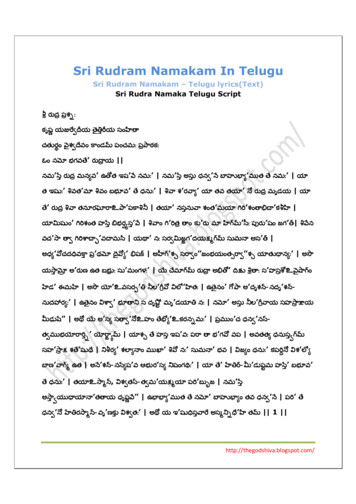
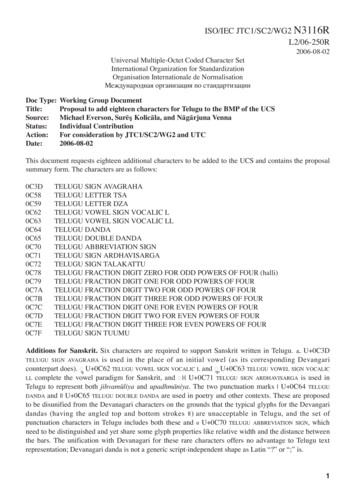
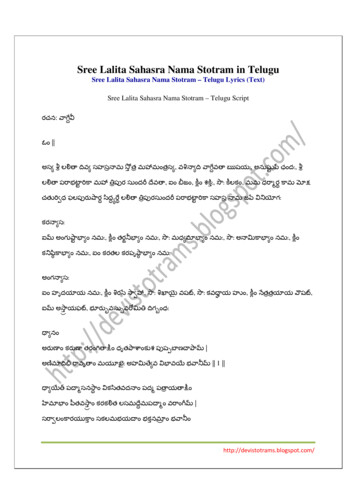
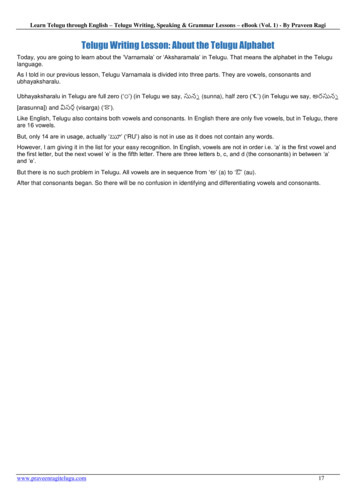
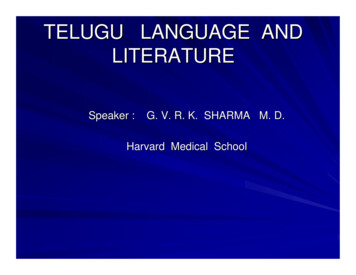
![Untitled-3 [mainetelugu ]](/img/4/telugu-alphabet-workbook.jpg)
